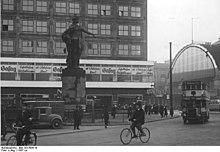Berolina

Berolina is the neo-Latin name for Berlin and the personification of the city of Berlin. The best-known portrait of a Berolina is the statue by Emil Hundrieser , which was unveiled in 1895 and formerly stood on Berlin's Alexanderplatz .
prehistory


In 1871, Kaiser Wilhelm I had an eleven-meter-high Berolina set up as jewelry on Belle-Alliance-Platz for the entry of troops victorious in the Franco-German War .
Emil Hundrieser and Michel Lock designed another Berolina as a short-term festive decoration for Potsdamer Platz on the occasion of King Umberto's visit of Italy in 1889. The 7.55 meter high figure was made in plaster and showed a woman with an oak wreath . The model is said to have been a painting from the Red Town Hall , which depicted the Berlin shoemaker's daughter Anna Sasse.
History of Berolina on Alexanderplatz

Finally, Emil Hundrieser changed the design slightly. This from metalsmith Friedrich Peters in copper driven Berolina statue was unveiled on 17 December 1895 before the "you Trosselschen house" in the Alexander Street 70, the 1904 the department store had to give Tietz. During the November Revolution in 1918 , the figure was damaged and briefly repaired in Treptow . At the beginning of 1927 it had to give way to the construction of the underground . After the magistrate did not actually want to rebuild the statue, as it was too reminiscent of the Wilhelmine era , at the insistence of Berlin citizens and the press in December 1933 it was re-erected on a simpler base in front of the Alexanderhaus . On August 26, 1942, the statue was finally dismantled and, after it was last seen at the Neukölln freight yard, it was probably melted down for war purposes . The base was removed in 1958. According to contemporary witnesses, it is said to have been buried on the Müggelturm along with other rubble.
The 7.50 meter high Berolina figure made of copper stood on a 6.25 meter high plinth made of red Swedish granite . With her right hand she held the Berlin coat of arms , with her left she pointed - according to Heinrich Zille - to a nearby public lavatory . She wore the crown of the city wall on her head . In the Märkisches Museum there is a reduced model of the Berolina statue. The five-ton figure was affectionately called "Bärenlina" by the Berliners. Alfred Döblin described the statue in his novel Berlin Alexanderplatz , published in 1929 :
“Everything is covered with boards. Berolina was standing in front of Tietz, one hand outstretched, was a colossal woman, she was dragged away. Maybe they melt them down and make medals out of them. "
In order to rebuild the Berolina statue, the “Friends of the Berolina Association for Reconstruction and Maintenance” was founded in 2000. V. “founded. According to the development association, an entrepreneur has already been found who would finance their reconstruction.
reception
Many Berlin companies use the Berolina name , and there have been numerous broadcasts on radio and television in the past that referred to the Berolina. Berolina is also the nickname of the operations control center of the Berlin police and part of the name of the chess club Berolina Mitte . An office building built on Alexanderplatz based on designs by Peter Behrens between 1929 and 1932 was named Berolinahaus because of its proximity to the Berolina statue .
In the 1980s there was the Berolina TV Music Prize from ARD , ZDF and ORF , which was presented to 15 musicians and bands on August 27, 1987 in a TV show hosted by Thomas Gottschalk . Prize winners were Falco , Münchener Freiheit , a-ha , Juliane Werding , Joe Cocker , Jennifer Rush , Peter Maffay , Engelbert , Chris de Burgh , Erste Allgemeine Verunsicherung , Tina Turner , David Bowie , ZZ Top , Clowns & Helden and Udo Jürgens .
There are also many songs, poems, songs and plays, for example by Kurt Tucholsky and Günter Neumann . The SFB named a radio program around the Berolina (with Ulli Herzog and Alexander von Bentheim ).
The historic Berolina is a symbol of the Berlin women's movement .
literature
- Gernot Jochheim : Der Berliner Alexanderplatz , 2006, p. 101.
Web links
- The history of Berolina on anders-berlin.de
- Website of the Association for the Promotion of the Berolina Statue
Individual evidence
- ^ Adolf Rosenberg : Michael Lock. In: Berliner Architekturwelt. 1. Jg., H. 11, 1899, S. 360-370, here S. 366, online (PDF; 26.7 MB) .
- ↑ Kunstchronik NF VII, No. 10, December 27, 1895, Col. 160.
- ↑ That you Trosselsche house.
- ↑ a b According to the report in the evening show of November 30, 2014.
- ↑ Collection online. Retrieved December 2, 2018 .
- ↑ p. 258, Fischer Taschenbuch, Frankfurt am Main 2017, ISBN 978-3-596-52149-4 .
- ↑ Annett Gröschner : Berolina's angry daughters. 50 years of the Berlin women's movement. FFBIZ, Berlin 2018, ISBN 978-3-9819561-1-5 .